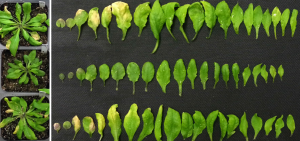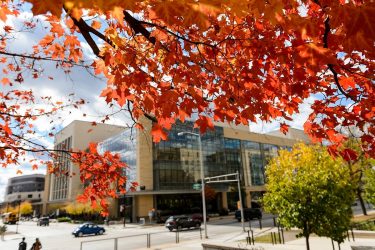An early November stroll under the many trees on campus at the University of Wisconsin-Madison reveals an astonishing assortment of yellows, reds, and oranges against the clear, blue autumn sky. But as Xuehua Zhong passes beneath the colored arboreal canopy on her way to her lab at the Discovery Building, she is not thinking only of the beauty of the fall season.
Zhong, an assistant professor of genetics in the Epigenetics theme at the Wisconsin Institute for Discovery, contemplates how science can unlock the mechanisms behind plant aging and how the timing of the burst of fall colors can be better understood through the lens of epigenetics.
“Epigenetics is one of the important players in the cross-talk between the environment and our bodies.”
Epigenetics is the study of the epigenome, the chemical layer of information that acts as the connection between the environment and the genome, dictating which genes are expressed — or “turned on” — under which conditions. Without any change to the DNA sequence, epigenetic modification can drastically alter the characteristics of a cell, structure, or even an entire organism.
Zhong’s research has focused on how gene expression in growth and development is regulated by epigenetic modification and how that regulation can be influenced by environmental stimuli. “Epigenetics is one of the important players in the cross-talk between the environment and our bodies,” says Zhong. She is interested in how stable epigenetic modifications might be, and whether and how they can be passed from one generation to the next.
As an example, Zhong points to environmental differences between the fast-approaching Wisconsin winter and the much warmer climate of Texas. She asks, “is our epigenome different in Wisconsin versus Texas?” She then points out that we can learn a lot about the nature and stability of epigenetic modifications from much easier-to-study populations of organisms: plants.

Zhong uses Arabidopsis thaliana — or thale cress — as an experimental model to test her research questions. The small flowering Arabidopsis was the first plant to have its genome fully sequenced, which combined with its relatively short life cycle, makes it a great candidate for studying epigenetic regulation of biological processes across multiple generations.
Plant senescence, or aging, is an elaborate process vital to the life cycle of a plant. The efficiency of this process has critical implications for biological success: premature aging might result in a reduction in yield, a grave concern for the production of offspring and cultivation of crops. Belated senescence, on the other hand, reduces a plant’s efficiency by delaying reallocation of nutrients and may impact the viability of the next generation.
Several genes related to senescence have been identified in Arabidopsis, but the regulatory mechanisms by which the process of aging proceeds have remained a mystery. In a new paper published in eLife today, Zhong and her colleagues describe for the first time the role of a specific histone deacetylase (HDAC) complex in jumpstarting leaf senescence.


Histones are key proteins involved in epigenetic regulation around which DNA can be tightly or loosely wound. As they are modified by chemical signals, they spool or unspool their resident DNA, either suppressing or expressing the local genes.
The complex Zhong describes acts on previously identified genes that code for various components of the senescence process. By searching the Arabidopsis genome for locations where the HDAC binds, her group found evidence of a key player in the process. “We found that this protein binds to a lot of genes that have potential functions in the aging process. That provides some other information which led us to study the potential functions in [the process],” says Xiangsong Chen, a postdoctoral researcher working with Zhong and first author on the paper.
The newly-profiled HDAC and associated proteins regulate the signaling pathway for leaf senescence initiated by age or darkness, acting as the missing link between the environment and genome and promoting the onset of aging. This new insight into the mechanism of aging is a significant step forward in epigenetics research and may have implications for agricultural production and crop yields.
And for Zhong, it makes the fall colors more beautiful than ever.
— Nolan Lendved


You must be logged in to post a comment.